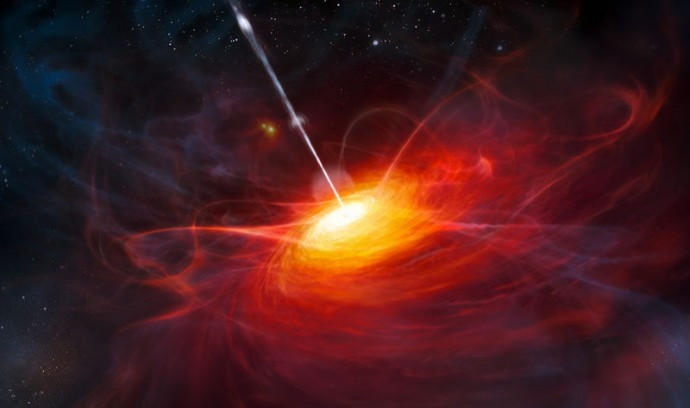Galactic hailstorm in early universe observed, gives clues to galaxy formation

Researchers at the University of Cambridge have looked back nearly 13 billion years at the early universe to see how quasars influence the evolution of new galaxies.
Using radio telescopes and computer simulations, they were able to watch the distant luminous objects (quasars) throw out cold gas at high speeds of 2,000 kilometres per second across 200,000 light years.
The cold gas is the primary fuel for star formation and the main ingredient of galaxies. How the gas is accelerated to such distances where it can trigger new star formations was not understood till now.
The observations and computer simulations explained this.
Heated to millions of degrees by the energy released by nearby supermassive black hole, the hot gas is released under tremendous pressure. On its way out of its parent galaxy, some of the gas cools by radiative cooling to be observable by radio telescopes.
"It is the first time that we have seen outflowing cold gas moving at these large speeds at such large distances from the supermassive black hole," said Claudia Cicone, a PhD student at Cambridge's Cavendish Laboratory and Kavli Institute for Cosmology, and lead author on the first of two papers.
"It is very difficult to have matter with temperatures this low move as fast as we observed."
The results are published in the journals Monthly Notices of the Royal Astronomical Society and Astronomy & Astrophysics.
"The amazing thing is that in this distant galaxy in the young Universe the conditions are just right for enough of the fast moving hot gas to cool to the low temperatures that Claudia and her team have found," said Tiago Costa, a PhD student at the Institute of Astronomy and the Kavli Institute for Cosmology, and lead author on the second paper.
The team used the IRAM Plateau De Bure interferometer in the French Alps to gather data in the millimetre band which allows observation of the emission from the cold gas.
The cold gas is almost invisible at other wavelengths.
Quasars are not fully understood beyond being centres of very distant galaxies. Most scientists believe they are the most distant objects in the universe, emitting trillion times the energy as our Sun or the combined energy of 100 normal galaxies.
The visible region represents a small fraction of the galaxy, with radio emission regions stretching far beyond.
Galaxies are believed to exhibit quasar properties in the early stages of formation.
© Copyright IBTimes 2025. All rights reserved.





















